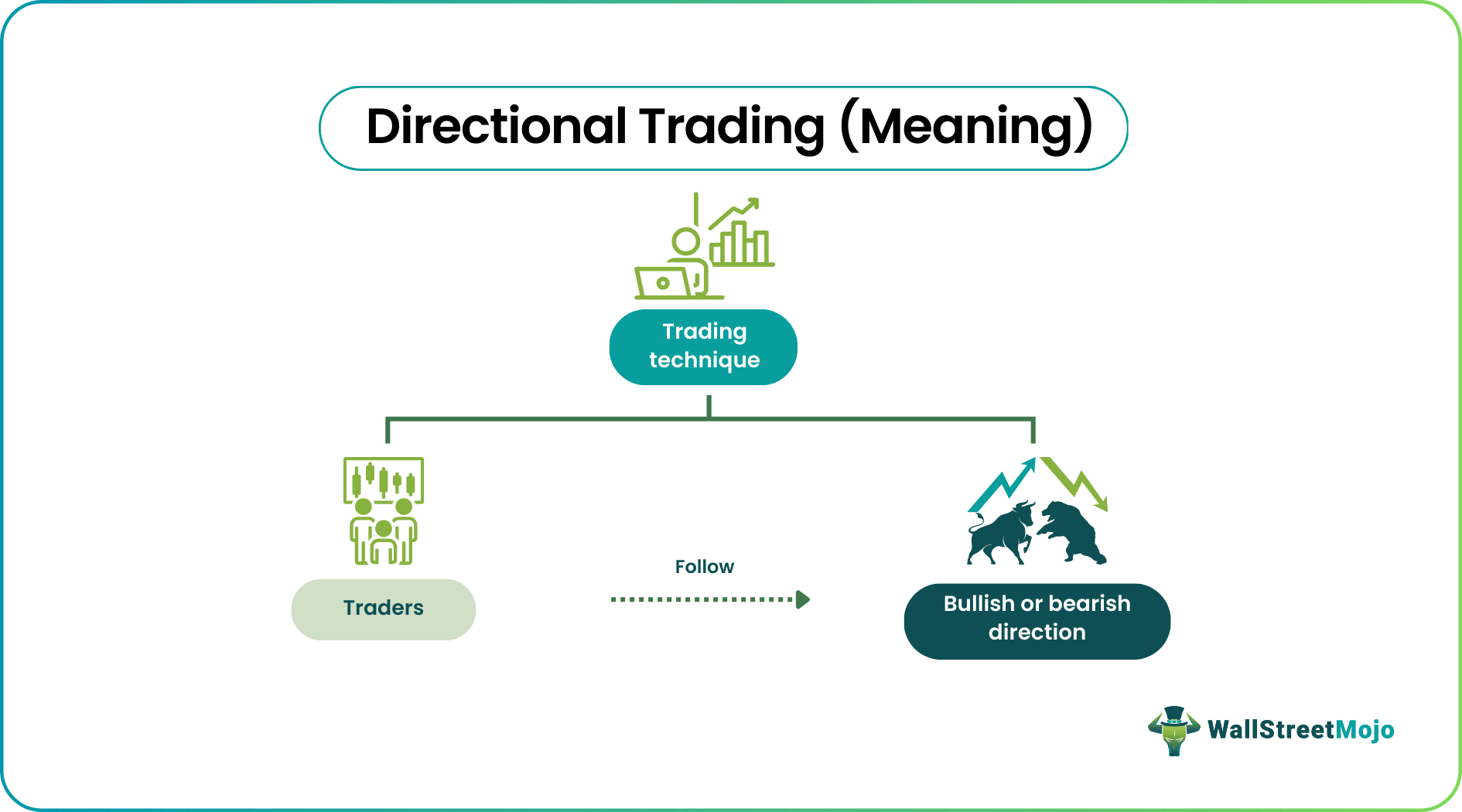Table Of Contents
What Is Directional Trading?
Directional Trading, in finance, refers to the trading technique that guides the investors in a certain direction, making them take positions, likewise. The prime objective of this strategy is to follow the trend depending on whether the market is bullish (buy) or bearish (sell).

Directional trading can help investors determine their investment strategy. It is mainly about predicting and capitalizing on the overall trend of an asset's price movement, whether it's expected to rise or fall, to generate profits from market movements in a specific direction. Essentially, directional traders' buy or sell decisions are based on their market direction forecasts.
Key Takeaways
- Directional trading is a stock market technique that guides traders and investors to follow a certain trend to invest in equities and other financial instruments.
- It is common in options trading, which includes various strategies such as bull call, bull put, bear call, and bear put.
- For example, traders may increase their positions in stocks if they observe bullish trends, while they may decrease their positions or engage in selling if bearish trends are detected.
- Market timing involves making investment decisions based on predictions of future market movements, aiming to capitalize on expected changes in market prices.
Directional Trading Strategies Explained
Directional trading with options is widely used to determine the market's direction and make trading decisions. In short, it provides a head start to the market's direction. For example, investors are likely to start buying equities if the stock market index is bullish (green). Likewise, for a bearish market, there will be a massive selling.
As it is associated with options, there are higher chances of profits and fewer losses to occur. The proper use of this technique limits the increasing costs, improves cash flows, and helps book profits. In addition, the constant use of this trading strategy attracts lesser volatility to the portfolio.
Among the directional options trading, calls and puts are the major types. The traders witness a strong market swing in a specific option segment, depending on the trend detection from time to time. It can be either upward or downward. Even if the current market session has no volume, directional trading with options is still possible. However, they rely on one indicator rather than following many. For example, if the market segments for a stock are negative, the traders automatically start selling that stock. They will not conduct the technical or fundamental analysis. Instead, their focus will be on the market news.
Considering multiple or simultaneous strategies is necessary if the investment portfolio has various assets. If a trader tries to take long and short directional trading, it is termed market timing. In short, they will benefit from time and book profits within this period.
Many traders use Saxo Bank International to research and invest in stocks across different markets. Its features like SAXO Stocks offer access to a wide range of global equities for investors.
Types
Let us look at the types of directional trading to comprehend the concept better:
#1 - Bull Call
As a part of the call option, traders will buy the bull call when the strike price is lower than the market price. This call option enables the investors to buy a stock at a lower strike price. Later, the trader will sell it as the market price increases or surpasses the strike price.
There are multiple strategies applied to directional trading. Due to this, the investor could book profits. The payoff or break-even point is when the price crosses the strike price plus premium. Therefore, the profits for them are anything above it. However, a bull call's profit is unlimited until the market rises. However, the risk is limited to the amount of premium paid.
#2 - Bull Put
It is similar to bull calls. But the only difference is that bull put involves put options. It is a vertical spread strategy where two put options are traded. In short, the trader tries to buy puts at a lower strike price and sells another at a higher rate. Here, the payoff for them is much less compared to bull calls.
#3 - Bear Call
Traders usually in bear calls assume the market to fall. In such situations, they tend to sell a lower strike price option and buy another at a higher price. Here, the profits and losses are limited to the risk borne. There are higher profits when the prices are low. As they rise, the trader will witness unlimited loss.
#4 - Bear Put
Here, a bear put acts like a bear call where the former sells the put option and buys another put at a higher price. Also, there is decreased volatility. So, as the first put is sold, the trader collects a premium, which gets adjusted with another put.
Examples
Let us look at the examples of directional trading change for a better understanding of the concept:
Example #1
Consider Samuel, a swing trader. In the current scenario, his analysis indicates the market as bullish, pointing to upward price movement. This makes him buy stocks or options expecting to sell them later at a higher price, thus profiting from the anticipated price increase. This strategy relies on the trader's ability to accurately forecast market trends and make informed decisions based on their predictions.
Example #2
According to an article, recent scenarios suggest a growing confidence among investors in the Indian rupee. This is corroborated by the surge in trading volumes and indicating expectations of a breakout and rally. Forex traders express their views through currency options, especially in the dollar-rupee market, where a rise in the rupee's value against the dollar is forecasted. This trend reflects a broader sentiment driven by economic factors and central bank policies, with investors positioning themselves accordingly in the options market to profit from directional movements in currency pairs.
Directional Trading Strategies vs Non-Directional Trading Strategies
Although directional and non-directional trading strategies have similar techniques, they differ widely. Let us look at the differences between them:
| Key Poitns | Directional Trading Strategies | Non-Directional Trading Strategies |
|---|---|---|
| Meaning | It refers to the trading method of following a certain market direction, either bullish or bearish. | In non-directional trading, there is no market direction followed by the traders. |
| Objective | To book profits, the traders focus on certain market positions. | To earn profits irrespective of what others are following. Here, the traders will follow any direction and not just one. |
| Types | Bull call, Bull put, Bear call, Bear put. | Strangle, Butterfly, Condors, Leg Spreads, and many more. |
| Accuracy | Here, the prediction and execution of the strategies are accurate. | These strategies may sometimes result in inaccurate predictions because they do not rely on specific market directions. |
For professional-grade stock and crypto charts, we recommend TradingView – one of the most trusted platforms among traders.
Disclosure: This article contains affiliate links. If you sign up through these links, we may earn a small commission at no extra cost to you.
Frequently Asked Questions (FAQs)
Volatility trading involves buying and selling stocks based on fluctuations in market prices. At the same time, directional trading focuses on anticipating the overall trend of an asset's price movement. In other words, it is about identifying the existence of trends like bullish or bearish.
Directional trading in horse racing refers to betting on specific horses based on predictions of their performance and likelihood of winning a race. Similar to financial markets, where traders invest based on anticipated price movements, individuals in horse racing engage in directional trading by selecting horses they believe will perform well and yield profits.
Directional trading change strategies are important. It helps to benefit from the anticipated market movements. By predicting market trends, traders can strategically position themselves to maximize profits. These strategies help investors navigate market fluctuations, make informed decisions, and optimize their investment portfolios for better returns.

